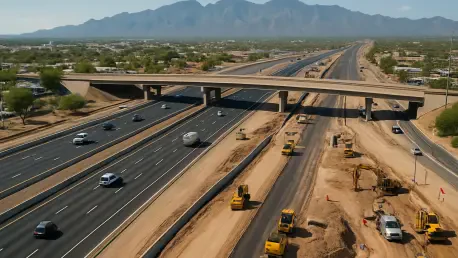As we dive into the world of highway construction and infrastructure innovation, I’m thrilled to sit down with Luca Calaraili, a seasoned expert in construction with a deep background in design and architecture. With a passion for integrating technology and innovative tools into the industry, Luca brings a wealth of knowledge to the table. Today, we’ll be exploring a major highway project in Tucson, Arizona, focusing on the modernization of a key stretch of I-10. Our conversation will touch on the project’s scope, its impact on the local community, the collaborative efforts behind it, and how it fits into broader transportation goals for the region.
Can you walk us through the major highway project happening on I-10 in Tucson and what it aims to achieve?
Absolutely, Julien. This project focuses on modernizing a three-mile stretch of I-10 between Kino Parkway and Country Club Road. It’s a significant undertaking, valued at $600 million, and it’s all about improving traffic flow, enhancing safety, and updating infrastructure to meet current and future needs. The main goals are to reduce congestion and create a more efficient corridor for drivers in this busy part of Tucson.
What specific improvements are being made to this section of I-10, and why do they matter?
We’re expanding the highway to three general-purpose lanes in each direction, which will greatly increase capacity. Additionally, the existing interchanges are being removed and redesigned to streamline traffic movement and minimize bottlenecks. There’s also a new westbound entrance ramp and an undercrossing being built, which will improve access and connectivity. These changes are crucial for reducing delays and enhancing safety for everyone using this stretch.
How does this project connect to the broader transportation vision for the Tucson area?
This initiative is actually the first major step stemming from a comprehensive 2020 study on I-10 and State Route 210. That report laid out a long-term plan for upgrading key corridors in Tucson, and this specific segment was prioritized in the state’s 2024-2028 Five-Year Transportation Facilities Construction Program. It’s a foundational piece of a larger puzzle to create a more integrated and efficient transportation network across the region.
Let’s talk about the financial side. How is a project of this scale, worth $600 million, being funded?
The project is fully funded through state resources and allocations outlined in Arizona’s transportation program. What’s noteworthy is that it’s insulated from external disruptions like federal government shutdowns, ensuring the timeline and budget remain on track. This stability is critical for a project of this magnitude and allows us to focus on delivery without financial hiccups.
Can you share some insight into the partnership driving this project and how responsibilities are split?
Certainly. This is a design-build partnership, which means one team handles both the design and construction phases for better coordination. My colleagues at Jacobs are leading the final design of structures and preparing detailed engineering documents, while Sundt, based in Tempe, manages much of the on-the-ground construction work. Together, we ensure that innovative ideas in design translate seamlessly into practical, high-quality infrastructure.
What makes this particular project a standout in the realm of highway construction in Arizona?
This effort is often seen as a pioneering program because it introduces advanced practices in alternative project delivery to the state. We’re not just building a road; we’re setting a precedent for how large-scale infrastructure can be approached with efficiency and innovation. It’s about adopting best practices that could shape future projects, making this a benchmark for others to follow.
How do you see this modernization impacting the local community once it’s completed?
The benefits are going to be substantial. Drivers will experience smoother traffic flow with fewer delays, which is a huge plus for daily commuters and freight movement. Safety is another big win—updated designs and expanded lanes will reduce the risk of accidents. Beyond that, better connectivity will support economic growth in Tucson by making the area more accessible and attractive for businesses and residents alike.
Looking ahead, what is your forecast for the future of highway infrastructure projects in Arizona based on this initiative?
I’m optimistic that this project will pave the way for more innovative and community-focused infrastructure work in Arizona. We’re likely to see an increased emphasis on design-build partnerships and the integration of technology to tackle complex challenges. As urban areas continue to grow, I expect a stronger focus on sustainability and resilience in highway projects, ensuring they meet the needs of future generations while addressing current demands.









